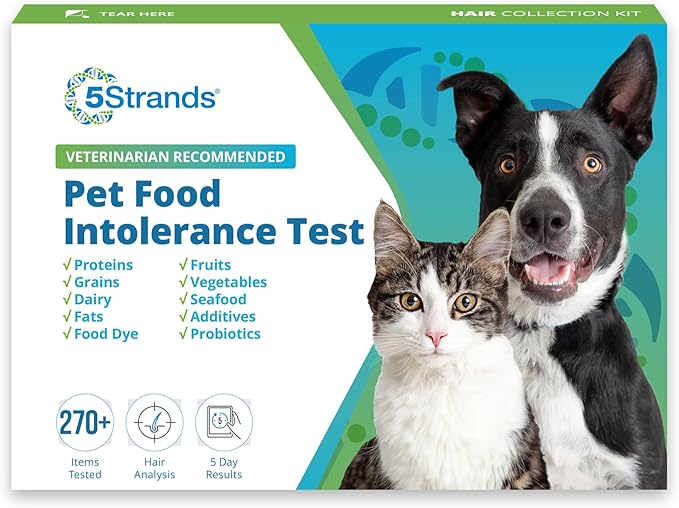Getting your dog an allergen test can save you a ton of time.
The best and worst part of having a dog is that they can’t talk. When I’m upset, nothing sounds better than my best buddy talking me up and telling me what he thinks. But at the same time, I don’t really want to hear about how bored he is or how much he dislikes when I go somewhere without him. Such is life.
Since dogs can’t tell us how they feel, we have to observe their behavior and physical traits to figure out how best to take care of them. We examine their coat, behavior, and, yes, even the piles they leave on the lawn to get an idea of what’s happening in their bodies. But that’s about it, making the process pretty inefficient.
The easiest and best way to take care of our furry friends is to give them the right food. Dogs’ lives are simple. They want to run, play, jump, sniff, chew, and otherwise terrorize our yards. For them to do all that, they need healthy guts, skin, muscles, bones, teeth, etc. And it all starts with their food. You can supplement all you want, but we are what we eat—and that’s no different for our four-legged friends. This means we have to find the right food, without them being able to tell us.
So, what is the right food?
The answer isn’t simple. We can look at individual breeds and gather statistics on what they’re usually allergic to or what typically works best. But again, they can’t talk. Your dog can’t tell you, “I get a tummy ache when you give me peanut butter.” And what’s usually best for a breed doesn’t apply to all dogs. We’re left with our observations, trial-and-error, and allergy tests.
It’s important to note that allergy testing isn’t conclusive or even highly effective. Some methods have shown middling results at best. If you do choose to get one, know that they’re not 100% accurate. I’ve had three tests done for Rambo at various stages of his life. What I got was a bunch of papers listing ingredients to avoid. After three rounds, I just took the top ten repeated allergens and ran with those.
There’s really only one highly effective way to figure out what your dog can and can’t eat, and that’s an elimination diet. If you’ve done one before, I get it—you’re probably groaning out loud right now. It’s OK, buddy. They’re worth it.
Why would anyone groan? Because elimination diets are time-consuming, often frustrating, and require intense attention to detail. They can take a long time to complete and demand strict discipline from you, the dog owner. Here’s how an elimination diet goes:
1. Reflection
Make a list of everything you’ve given your dog over the past few months—table scraps, crumbs on the floor, treats, food, even the types of sticks they’ve chewed at the park. Then, go through every ingredient list you can find and write down every last thing they’ve come into contact with over the past three months. This might even include the detergents you use on your clothes and the chemicals used to clean your house. It’s a lot, so crack open a beer, order some Thai food, and get to work.
2. Figure out what they haven’t eaten.
For most dogs, this will be something like duck or rabbit. Rambo was special because he was in a lavish daycare as a puppy. So for Ritzy Rambo, I had to get food with kangaroo in it (spoiled little…). Whatever it is for your dog, feed them this protein and nothing else for 6-12 weeks.
A few things to remember: keep your dog away from other dogs’ food bowls, shared water bowls, and food counters. Even trace amounts of other foods can trigger allergic reactions and ruin your efforts. Also, processed treats are completely off-limits. You’ll need to be vigilant around other dogs and their owners. Not only will they be giving their dogs treats, but other dogs have… orifices that can ruin everything. You know what I mean.
There are alternatives for treats. Carrots are my go-to because they’re the only vegetable Rambo will eat. Most veggies and some fruits are fine, but always check to make sure they’re safe for your dog. If you need something to hide medications in or just want to spoil your dog, peanut butter works for me—but be aware, your dog might be allergic to peanut butter too! It’s all give and take.
3. The Journal
Just writing those words irritates me. I have pages and pages of the dreaded “itch journal.” It’s exactly what it sounds like. I wrote down every time I saw my dog itching, chewing his paws, or acting squirmy. Then I’d go back in my mind to figure out where he was or what he ate that day.
4. Back to the old diet.
Remember, you’ll be keeping the journal and doing the elimination diet for 6-12 weeks. Stay strong and disciplined. You should see improvement within 2-3 weeks. Rambo showed improvement in one! Turns out the poor guy was allergic to just about everything. Your vet will be your best friend during this time. I scheduled check-ins with a vet tech every week or two to monitor Rambo’s weight, skin, etc., as we went through the process. His issues were mostly gastrointestinal, but skin problems take longer to improve, which is why the diet can last so long. Your vet can run tests to ensure everything’s improving as it should.
Eventually, though, you’ll have to return to the old food. This can be scary, especially if your intuition tells you the old food was the problem. But unfortunately, it’s the only way to know for sure. If your dog starts having the same issues, go back to the limited diet they did well on and slowly reintroduce other ingredients. And don’t forget to keep tracking everything in your journal!
As you can see, elimination diets are a headache just to think about. That’s why I advocate for allergy testing. For me, it was a game-changer. Rambo has so many allergies that it was almost impossible to find any food that didn’t contain something he reacted to. During his elimination diet, I ended up making his food from scratch, which meant hours spent preparing meals on top of everything else—work, walks, the park… you get the picture. While these tests aren’t conclusive, they can save you a lot of time.
I had three tests done for Rambo, and for me, one clear winner emerged: 5Strands (link below). Based on the elimination diet and the other tests, this was the one that most accurately identified Rambo’s allergies. Am I a PhD? Nah. A licensed vet? Nope. But this worked for me. The ~$100 I spent on the test narrowed down my options and saved me a lot of time, so now I recommend it to others.


Leave a Reply